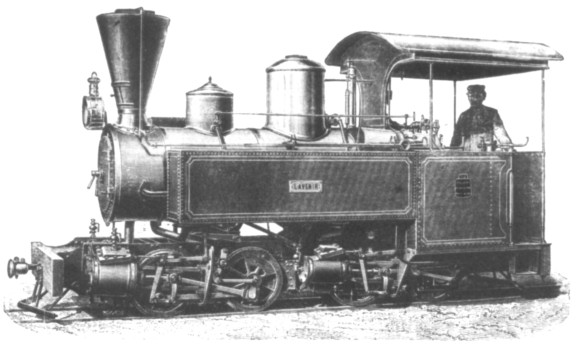
| THE INDUSTRIAL RAILWAY RECORD |
© OCTOBER 1973 |
CORRESPONDENCE
THE BRITISH NORTH BORNEO STATE RAILWAY
It would appear that locomotives 14, 15 and 16 of this railway (see RECORD 30, page 242) were originally ordered from W.G. Bagnall Ltd of Stafford. An entry in their order book dated 17th November 1948 (and later cancelled) shows the customers for order numbers 2997‑99 to be the Crown Agents for the Colonies, North Borneo Railway. Had these Bagnalls been built, they would have been somewhat smaller than the eventual Vulcan Foundry locomotives and had 13in by 16in cylinders, 3ft 6½in driving wheels and six wheel tenders with a 1500 gallon water capacity. As a point of interest I understand that these three Vulcans for the BNBSR were the last steam locomotives built by that firm.
| NEWCASTLE, STAFFS |
ALLAN C. BAKER |
FREDERICK COLLINS
I was interested to see the reference to driver Collins in RECORD 32, page 305. He was-also mentioned on pp219-220 of the January 1913 "Great Central Railway Journal" and a photograph showed him standing alongside Logan & Hemingway's No.5 AJAX (Manning Wardle 452 of 1873). "Building News" of 1st August 1913 reported his death on 1st June 1913, aged 75, at Claremont, Sherwood Rise, Nottingham. He left £66,888 - £63,001 net. Surely the best paid contractor's driver ever!
| BOLTON, LANCS |
FRANK D. SMITH |
THOMAS ROBINSON & SON LTD
Further to my letter on pp145-147 of RECORD 39, there is a technical article on this firm in "Iron", issue dated 9th August 1873. Copious details are given of the woodmaking machinery manufactured, and an accompanying engraving shows two locomotives (drawn too small to permit identification) at work in the yard with a vertical boilered steam crane. The article mentions that the firm made "steam engines" but gives no further details.
| BOLTON, LANCS |
FRANK D. SMITH |
KERR STUART ENGRAVINGS
With reference to the engraving on page 170 of RECORD 40, I can give details of the first ever 0‑4‑4‑0 Mallet, which was built by Ateliers Metallurgiques in Tubize, Belgium, and saw service on a 600mm gauge Decauville line. This locomotive, displayed by Decauville at the Paris Exhibition of 1889, is illustrated in "The Engineer" for 24th May 1889, and is clearly Kerr Stuart's inspiration for their own engraving. Details of a similar 0‑4‑4‑0 Mallet four cylinder compound, built under licence by A. Munktella (works number 27) and now preserved in the Railway Museum at Gavle, Sweden, can be found in "Preserved Locomotives of Western Europe" (Volume 2) by P. Ransome-Wallis.
| CRICK, RUGBY |

Decauville Type No.8 Mallet's Patent Compound Jointed Locomotive, weighing 9½ tons empty (12 tons in working order); to burn wood, coal or coke. Able to ascend 8% gradients on curves of 20 to 35 metres radius with 19lb rails; 600mm or 750mm gauge.
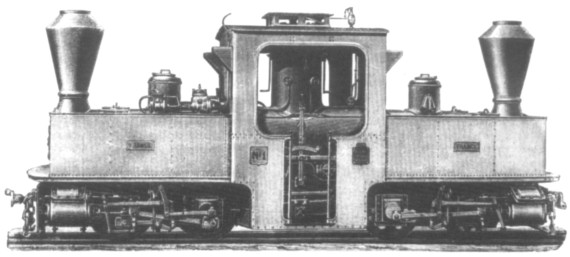
Decauville Type No.9. Duplex Jointed Locomotive, weighing 9½ tons empty (12 tons in working order) with two driving bogies and single boiler. Able to run over curves of 20 to 35 metres radius and ascend 8% gradients with 19lb rails; 600mm or 750mm gauge. (courtesy C.S. Small)
I am almost certain that the 0‑4‑4‑0 tank depicted in the engraving which appeared on page 170 of RECORD 40 never existed. If this is compared with the illustration of Decauville's 0‑4‑4‑0 60cm gauge Mallet tank which appeared in their 1899 and 1901 catalogues, the source of Kerr Stuart's engraving is apparent. The engraver of "The Railway Engineer" made a rather poor job of copying, for example on the Belpaire firebox top. Note also the hand lever which operates the damper over the top of the chimney of the Decauville model. On the Kerr Stuart version this is outside the cab, terminates abruptly just beyond the dome, and appears to be a detachable fire-iron! One could make quite a large collection of engine engravings which were copied from other makers' catalogues and never actually built.
| COS COB, CONNECTICUT, USA |
CHARLES S. SMALL |
(Page 43 of Decauville's 1889 Catalogue, from which the illustrations opposite are taken, was headed 'Mallet's Patented Compound Jointed Locomotive’. The description (with minor grammatical and orthographical corrections to the French-type English) indicated that this type of locomotive 'specially intended for railways is particularly adapted and to these new lines and very powerful. [? incorrect translation]. This locomotive has four axles and is jointed to enable it to run on curves of a radius of 20 metres and can ascend gradients as steep as 8 per cent. On the level and in a straight line it will draw 280 tons, and this power, decreasing gradually, is still 10 tons on gradients of 6 per cent, and 5 tons on gradients of 8 per cent. It weighs 9½ tons empty (12 tons in full working order). By applying the compound system, all four axles drive, the hind-carriage fixed to the boiler being fitted with two cylinders which receive the steam at 12 atmospheres, and the truck is fitted with two cylinders of larger diameter in which the steam arrives with a pressure of 5 atmospheres. A saving of combustible [fuel] of 15% is effected by this system. The firebox is constructed to burn coal, wood or petroleum oil. The locomotive is [rated at] 85 horse power and is the most powerful ever made to run upon a 60 centimeters gauge, with rails of 9k, 500. It is suitable for very interesting undertakings over uneven ground.'
The captions opposite are those used by Decauville (with slight modifications). Ever-rising prices are not confined to the 1970's for the catalogue page has been rubber-stamped in one corner to say (in French) that as from 1st February 1890 the advertised prices were increased by 10% (track), 5% (wagons) and 2% (locomotives). - KPP)
BAKER PERKINS LTD
The following notes on the rail system of Baker Perkins Ltd may prove of interest to readers following the reference on page 166 of RECORD 40. As far as the locos are concerned Pocket Book D lists an English Electric OHW (overhead wire) electric locomotive seemingly replaced by a Ruston & Hornsby diesel bought new in 1944. This latter loco was sold for scrap, being sent to G.W. Bungey, Hayes, in August 1960.
I am enclosing a 1914 view of the works (regrettably not suitable for reproduction — TJL) which shows a rail system with a loco on a rake of trucks and an OHW system in part of the yard sidings. The system was extremely active during World War 2, but gradually declined until the connection to British Railways was removed in June 1971. The actual connection was a link to the old M&GN line, closed to passenger traffic in 1959 and completely a little later. Subsequently access to Baker Perkins meant keeping open a few hundred yards of the M&GN from the ex‑Midland Railway line at Wisbech Junction. Closure of the connection followed track modifications in the Peterborough area which saw the end of the link from the ex‑Great Northern main line to the old Midland line at Wisbech Junction. Latterly works traffic was very sparse and consisted of a few regular wagons of scrap iron, plus the occasional wagon from the continent. Internal shunting was achieved by a dumper truck fitted with a sleeper at buffer level.
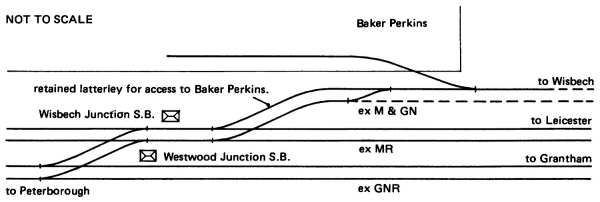
| PETERBOROUGH |
A.M. BURGESS |
A FOX WALKER MYSTERY
The preserved Fox Walker 0‑4‑2 locomotive illustrated on page 194 of RECORD 41 and masquerading as No.1, is in reality former Cordoba & Tucuman No.7 AVELLANEDA (Fox Walker 223). As the authentic Cordoba & Tucuman No.1 CORDOBA (together with all but one of the other Fox Walker four coupled locomotives) was scrapped in 1895, this sole survivor was renumbered for exhibition purposes. Fox Walker 230 to 238 were 0‑6‑0 tender locomotives allocated Cordoba & Tucuman Nos.11 to 19 and named respectively: BELGRANO, PROGRESO, RIOJA, JUJUY, SAN JUAN, SALTA, SANTA FE, SANTIAGO, and CATAMARCA. However, it would appear that for some reason No.238 never reached the line, as Argentine records show No.19 as being Fox Walker 241. Apart from Nos.17 and 18 which became Central Northern 4 and 5, the rest passed to the Central Cordoba (Northern Division) and retained their former numbers. Unlike the four coupled Fox Walkers most of them survived until the late 1920's.
| LONDON SW10 |
E. TONARELLI |
EARLY DIESEL LOCOMOTIVES
I read with interest Brian Webb's notes on pages 202-204 of RECORD 41 and can amplify his notes regarding locomotives built by Bagnall to Deutz designs: Bagnall appear to have first advertised their connection with Deutz in the "Railway Gazette" for 16th June 1933 with the proud boast of 'over 9,000 locomotives constructed'. One was led to believe that these had been built at Stafford as the works in the background of the advertisement photograph had been touched up to read 'W.G. Bagnall Ltd.' ! The selling agents were shown as Porn & Dunwoody Ltd, 72‑78 Fleet Street, London EC4 and the London agents as K.R. Pearson & Co, 32 Victoria Street, London SW1. In answer to Mr Webb's query, perhaps these two firms also acted as agents for the sale in Britain of imported Deutz locomotives. The list below shows the position regarding Bagnall diesel locomotives having Deutz engines and/or built to Deutz designs.
|
Works number |
date ordered |
date despatched |
type | gauge |
wheel diameter |
wheelbase |
| 2498 | 28-8-1933 | 23-3-1934 | 0‑4‑4‑0 | 1'‑10½" | 1'‑4" | 2'‑0" |
| 2499 | 18-11-1933 | 29-3-1934 | 4w | 1'‑115/8" | 1'‑2" | 1'‑115/8" |
| 2506 | 3-1-1934 | 17-5-1934 | 0‑4‑0 | 2'‑6" | 1'‑4" | 3'‑0¾" |
| 2507 | 3-1-1934 | 16-5-1934 | 0‑4‑0 | metre | 2'‑3½" | 4'‑71/8" |
| 2516 | 1-6-1934 | 22-1-1935 | 0‑4‑0 | 2'‑0" | 1'‑8" | 3'‑33/8' |
| 2524 | 10-11-1934 | 29-1-1935 | 4w | 2'‑0" | 1'‑2" | 1'‑115/8" |
| 2530 | 11-2-1935 | 9-1935 | 0‑4‑0 | metre | 2'‑3½" | 4'‑71/8" |
| 2567 | 9-6-1936 | 2-1937 | 0‑6‑0 | 2'‑6" | 2'‑9½" | 7'‑3" |
| 2573 | 10-12-1936 | 4-1937 | 0‑6‑0 | 2'‑0" | 2'‑6" | 7'‑3" |
| 2577 | 1-2-1937 | 6-1937 | 0‑4‑0 | 4'‑8½" | 2'‑9¼" | 5'‑3" |
| 2595 | 1-1938 | 5-5-1938 | 0‑4‑0 | 2'‑0" | 1'‑4" | 2'‑6¾" |
| 2498 |
Halkyn District United Mines Ltd, Flintshire. Deutz 2‑cyl 22/24hp engine. Shaft drive. Bagnall articulated design which utilised the first Deutz engine sent over from Germany. (See RECORD 16, page 131, for photograph and additional information.) The second diesel locomotive built by Bagnall. |
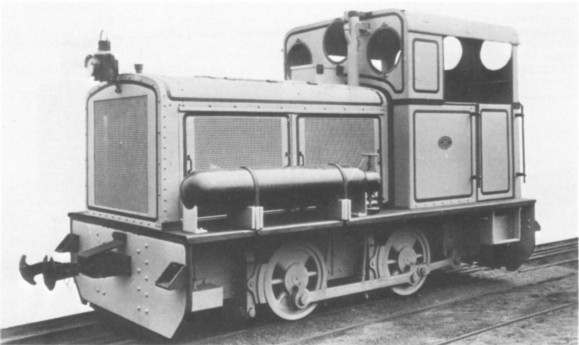
Official photograph of Bagnall 2507. As advertised this type could be designed for any gauge from 2ft 0in upwards. (English Electric Co Ltd)
| 2499 |
Oakeley Slate Quarries Co Ltd, Merionethshire. Deutz single cyl, 2‑stroke 8/8½hp engine, 1200rpm, 2 forward and 2 reverse speeds. Weight 2.8 tons (increased to 3.75 tons by the addition of ballast). Chain drive. Deutz design. |
| 2506 |
Budla Beta Tea Co Ltd, India, for use on their Pengarie - Digbot Trolley line in Assam. Deutz 2‑cyl vertical 2‑stroke 22/25hp engine of type OMZ 117, 700rpm, 4 speed gearbox. Gear drive on trailing axle. Weight in working order 4.5 tons. Deutz design. |
| 2507 |
Assam Railways & Trading Co Ltd, India. Deutz 2‑cyl vertical 2‑stroke 50hp engine of type OME 125, 500rpm, 4 speed gearbox. Jackshaft drive. Weight in working order 11.5 tons. Deutz design. |
| 2516 |
Coltness Iron Co Ltd, Lanarkshire. Deutz 4‑cyl vertical 4‑stroke 45hp engine of type FMV 117, 1,000rpm, 4 speed gearbox. Flameproof mining locomotive with jackshaft drive. Weight in working order 8.5 tons. Deutz/Bagnall design. |
| 2524 |
New Consolidated Goldfields Ltd, Gold Coast. Same as 2499 but with modified clutch. Chain drive. No extra ballast. Deutz design. |
| 2530 |
Assam Railways & Trading Co Ltd, India. Similar to 2507 but with a bigger Deutz 2‑cyl vertical 2‑stroke 70/77hp engine, 430rpm. Weight in working order 14 tons. Deutz/Bagnall design. |
| 2567 |
African Manganese Co Ltd, Gold Coast, "A.M.C. No.14". Six‑wheeled version of 2530 with Deutz 3‑cyl vertical 2‑stroke 110/130hp engine, 450rpm, 4 speed gearbox, Westinghouse air brake. Weight in working order 18 tons. Deutz/Bagnall design. |
| 2573 |
Sir J.L. Hulett & Sons Ltd, Natal, South Africa, "DARNALL No.2". Similar to 2567 with same type and size of engine, but weight in working order 16.5 tons. Deutz/Bagnall design. |
| 2577 |
F.H. Lloyd & Co Ltd, Wednesbury, Staffs, "V.L.3". Similar to 2530 with same type and size of engine, but weight in working order 22 tons. Deutz/Bagnall design. |
| 2595 |
Budla Beta Tea Co Ltd, India. Similar to 2506 but of different gauge and Deutz single cylinder vertical 2‑stroke 11/12hp engine of type OME 117, 4 speed gearbox. Gear drive. Weight in working order 4 tons. Deutz/Bagnall design. |
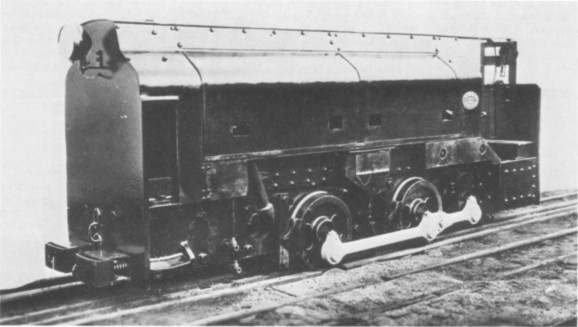
Official photograph of Bagnall 2516. As advertised this type could be designed for any gauge and any power from 8½hp upwards to suit customers' requirements. (English Electric Co Ltd)
| NEWCASTLE, STAFFS |
ALLAN C. BAKER |
TAKER ROASTER
This locomotive, discussed on page 231 of RECORD 42, was among the largest of Chaplain's vertical boiler machines at this period. Rated at 15hp, it was built new for the Bridgewater Trustees, Bolton-le-Moor. By 1885 it was recorded as being at Sanderson's Siding, Worsley, close to the canal basin referred to by Mr Hayes.
| KILSYTH, GLASGOW |
J.S. BROWN LIE |
PECKETT & SONS
It may interest readers to know that FRANCISCO FERREIRA, illustrated on page 232 of RECORD 42, was actually a Fox Walker locomotive, works number 406 of 1878. A 2‑6‑0 with 13in by 20in cylinders, it was one of a batch of three similar class Z (also quoted as class 405) metre gauge engines supplied to the Unino Minero Brazilian Railway, the other two being 405 DOMBRIGADOR and 407 COLONEL REZENDI. They had 3ft 6½in coupled wheels (on a 10ft 0in coupled wheelbase) and were fitted with a tender capable of carrying 1,000 gallons of water and 50cwt of coal.
| BRISTOL |
"ATLAS" |
GUIDE TO THE SOUTH AFRICAN COALFIELDS
Frank Jones has reminded me that the photograph of the 2‑8‑4 tank at Coalbrook (RECORD 43, page 251) was not taken at the same time as the others, but several years before. Also, vide page 259, there are two stockists of maps in Johannesburg, the Map Centre and the Map Office.
| RICHMOND, SURREY |
FRANK JUX |
I can add a little to the information given in the caption on page 251 of RECORD 43. The locomotive is a K class design of the Western Australian Government Railways, of which 24 were built over a period from 1893 to 1898. Undoubtedly that at Coalbrook Colliery was one diverted to South Africa at the out-break of the Boer War, possibly from a later batch.
| KALGOORLIE, WESTERN AUSTRALIA |
T.E. O'DWYER |
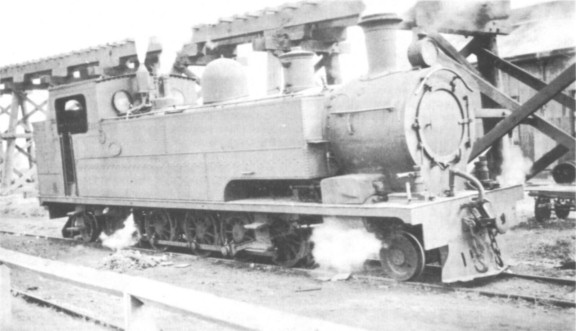
WAGR K class No.35 at Kalgoorlie in 1946. Externally this is very similar to the Coalbrook Colliery locomotive, although the latter sports several additions, including an extended bunker and flimsy hand-rails around the smokebox. (J.B. Goggs)
ROWNTREE'S OF YORK
Mention is made in this article (RECORD 43, page 235) of the boiler of SWANSEA being tested to 240 lb/sq in, and then the working pressure being set at 160 lb/sq in. This rather infers that the boiler was defective but it is normal practice to test boilers to at least 1½ times the working pressure, the boiler then being stamped with the tested rate and date of testing. No mention is made of whether this is done with the boiler hot or cold, but the particulars are recorded for the insurers to allow the safety valves to be set to blow off at working pressure.
| RIPLEY, SURREY |
J.L. BUTLER |
(With regard to the "Marshall" locomotive illustrated on page 238, Frank Jones has written to say that the firm of Walker Bros, who did build inside cylinder 0‑4‑0 tank locos, was another builder who used a brass band at the firebox end of the boiler. — TJL)
KERR STUARTS FOR SOUTH AFRICA
With reference to the rapid construction of the Kerr Stuart material for the Bezuidenhout Light Railway (page 329 of RECORD 45), Fielden's Magazine for February 1900 reported this event with the additional information that in putting the work out to tender the War Office had asked manufacturers to nominate their own minimum delivery periods, Kerr Stuart having thereupon offered to build everything in ten days. The date of placing the final order is not particularly significant as I have come across instances of the final order not being received by the builder until a day or so before completion of a locomotive, work having started on receipt of a provisional order some months previously. I would guess that Kerr Stuart were actually notified that they had won the order on 15th November, hence the immediate start on that date. There were a number of similar rapid feats reported about this time, for example the construction of replacement spans for the Colenso and Frerewere bridges by the Patent Shaft & Axletree Co Ltd in less than six weeks. Such speed was neither new or noteworthy, of course. In 1879 F.W. Webb had designed and fabricated the complete superstructure of the new Llandulas viaduct (after the original one had been swept away by a flood) in the space of seven days: not to be outdone the civil engineering side of the LNWR proceeded to rebuild the viaduct within twenty eight days of the disaster!
| KENILWORTH, WARWICKSHIRE |
RODNEY WEAVER |
I read with interest the letters from Mr Lomax (page 297 of RECORD 44) and 'Mecanicien II' (page 363 of RECORD 46) as the business connections between Kerr, Stuart; Dick, Kerr; and Hartley, Arnoux & Fanning have interested me for some time. "Machinery Market" for 1st November 1883 contains a brief note about the firm of W.B. Dick & Co of 101, Leadenhall Street, London EC. It states that 'the firm's works which are situated at Kilmarnock and Stoke-on-Trent, were established in 1850 and give employment, we understand, to over 1,000 men.' Two years later, "The Engineer" (issue dated 13th November 1885) carried an advertisement of Dick, Kerr & Co, giving the Leadenhall Street address, with works at Kilmarnock - the Britannia Works. There can be little doubt that the Kilmarnock works of Dick were those of Barr, Morrison & Co, who were certainly still going in 1882, and the Stoke works would be those of Hartley, Arnoux & Fanning, later taken over by Kerr, Stuart. All this supports the connection between Kerr, Stuart and Dick, Kerr, and of both with Hartley, Arnoux and Fanning.
The firm of Hartley & Arnoux Bros seems to have been established in Stoke between the years 1872 and 1876, as they do not appear in local directories prior to the 'former year, although at least one of the Arnoux brothers (Leon) lived in Stoke as early as 1868. The other brother (Ferdinand) and J.W. Hartley do not appear to have resided in Stoke for any length of time. The firm appears in directories and advertisements regularly until 1892, although in all those I have seen there is no mention of Fanning. Does anyone know who he was? I attach a photocopy of an early advertisement of the firm from an 1876 directory.
| WELLINGBOROUGH |
R. WEAR |
(The advertisement, which is too lengthy to reproduce, is headed "Hartley & Arnoux Bros, Engineers, Locomotive & Wagon Repairing Works," the address being "California Works, Stoke-on-Trent': They describe themselves as makers of railway plant of every description (especially points & crossings and colliery tubs), as well as millwrights, boilermakers and iron founders. The local pottery industry could be supplied with all kinds of castings and machinery, and they were agents for Carter's clay disintegrator and Blake's stonebreaker for crushing flint and Cornish stone. Repairs were 'promptly and efficiently executed" - KPP)
MIDGE
I am able to add a little to the information provided on page 364 of RECORD 46 regarding the Kerr Stuart locomotive named MIDGE. The line-block illustration also appears in a Brush catalogue of 1904 which states that MIDGE was available with cylinders in the 4in to 8in diameter range and could be adapted to work on any gauge from 1ft 6in to 3ft 6in. I have been unable to trace any information concerning the purchasers of Falcon 132 of 1887.
| NUNEATON |
M.H. BILLINGTON |